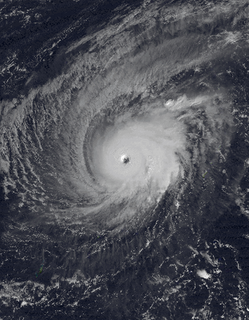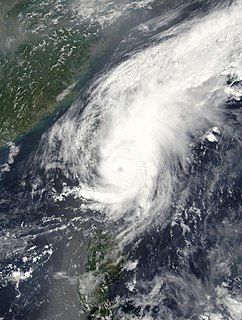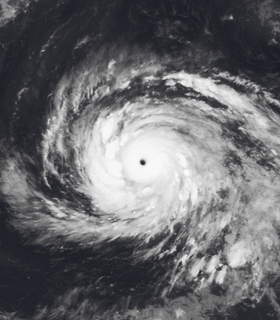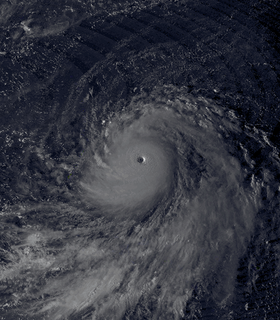
Typhoon Paka, known in the Philippines as Typhoon Rubing, was the last tropical cyclone of the 1997 Pacific hurricane and typhoon season, and was among the strongest Pacific typhoons in the month of December. Paka, which is the Hawaiian name for Pat, developed on November 28 from a trough well to the southwest of Hawaii. The storm tracked generally westward for much of its duration, and on December 7 it crossed into the western Pacific Ocean. Much of its track was characterized by fluctuations in intensity, and on December 10 the cyclone attained typhoon status as it crossed the Marshall Islands. On December 16, Paka struck Guam and Rota with winds of 230 km/h (145 mph), and it strengthened further to reach peak winds on December 18 over open waters as the final super typhoon of the year. Subsequently, it underwent a steady weakening trend, and on December 23 Paka dissipated.

The 2004 Pacific typhoon season was a very active season; it ran year-round in 2004, but most tropical cyclones tend to form in the northwestern Pacific Ocean between May and November. These dates conventionally delimit the period of each year when most tropical cyclones form in the northwestern Pacific Ocean.

Typhoon Pongsona was the last typhoon of the 2002 Pacific typhoon season, and was the second costliest United States disaster in 2002, only behind Hurricane Lili. The name "Pongsona" was contributed by North Korea for the Pacific tropical cyclone list and is the Korean name for the garden balsam. Pongsona developed out of an area of disturbed weather on December 2, and steadily intensified to reach typhoon status on December 5. On December 8 it passed through Guam and the Northern Mariana Islands while near its peak winds of 175 km/h. It ultimately turned to the northeast, weakened, and became extratropical on December 11. Typhoon Pongsona produced strong wind gusts peaking at 290 km/h, which left the entire island of Guam without power and destroyed about 1,300 houses. With strong building standards and experience from repeated typhoon strikes, there were no fatalities directly related to Pongsona, although there was one indirect death from flying glass. Damage on the island totaled over $730 million, making Pongsona among the five costliest typhoons on the island. The typhoon also caused Extreme damage on Rota and elsewhere in the Northern Mariana Islands, and as a result of its impact the name was retired.

Typhoon Kong-rey was a moderate typhoon that affected Guam and the Northern Mariana Islands in early April 2007. The first named storm of the 2007 Pacific typhoon season, Kong-rey became the earliest-occurring typhoon since Typhoon Sudal on April 6, 2004. At its peak, it was considered to be a Category 2-equivalent typhoon by the Joint Typhoon Warning Center, though re-analysis increased it to a Category 3-equivalent. Typhoon Kong-rey caused about $10,000 in damages and no injuries along its path.

Typhoon Conson, known in the Philippines as Typhoon Frank, was the first of the record ten typhoons to impact Japan during the 2004 Pacific typhoon season. Developing out of a tropical depression near the northern Philippines in early June, Conson slowly traveled towards the north. Gradually strengthening, the storm reached typhoon status late on June 7 according to the Joint Typhoon Warning Center and several hours later according to the Japan Meteorological Agency. After turning towards the northeast, the typhoon brushed Taiwan and reached its peak intensity with winds of 150 km/h on June 9. After reaching its peak, Conson gradually weakened, passing through Okinawa before being downgraded to a tropical storm the next day. On June 11, the storm made landfall as a minimal tropical storm in the Kōchi Prefecture just before becoming extratropical. The extratropical remnants continued towards the northeast and were last mentioned on June 14 crossing the International Date Line.

Typhoon Choi-wan was a powerful typhoon that became the first Category 5-equivalent super typhoon to form during the 2009 Pacific typhoon season. Forming on September 11, 2009, about 1,100 km (700 mi) to the east of Guam, the initial disturbance rapidly organized into a tropical depression. By September 12, the depression intensified into a tropical storm, at which time it was given the name Choi-wan. The following day, rapid intensification took place through September 14. Choi-wan attained its peak intensity on September 15, as it moved through the Northern Mariana Islands with the Japan Meteorological Agency reporting peak windspeeds of 195 km/h. Additionally, the Joint Typhoon Warning Center reported the storm to have attained winds of 260 km/h. The typhoon remained very powerful until September 17 when the storm's outflow weakened. The typhoon underwent an eyewall replacement cycle, leading to intensity fluctuations. By September 19, Choi-wan rapidly weakened as strong wind shear caused convection to diminish. The following day, the system transitioned into an extratropical cyclone and dissipated several hours later over open waters.

Typhoon Melor, known in the Philippines as Typhoon Quedan, was the second category 5 typhoon in 2009. It interacted with Typhoon Parma in the first week of October southeast of Taiwan.

Typhoon Roy, known in the Philippines as Typhoon Asiang, was the second-most intense January tropical cyclone on record in the Western Pacific basin. Forming out of an area of disturbed weather on January 7, 1988, Roy quickly intensified as it moved through the Marshall Islands. By January 9, the storm intensified into a typhoon and attained its peak intensity the following day. At its peak, sustained winds reached 215 km/h (135 mph). Slight weakening took place before the storm moved through the Mariana Islands. Continuing westward, the system eventually struck the Philippines as a minimal typhoon before dissipating over the South China Sea on January 19.

Typhoon Keith was the tenth of a record eleven super typhoons to develop during the unusually intense 1997 Pacific typhoon season. Originating from a near-equatorial trough on October 26, the precursor depression to Keith slowly organized into a tropical storm. After two days of gradual strengthening, the storm underwent a period of rapid intensification on October 30 as winds increased to 195 km/h (120 mph). On November 1, the storm further intensified into a super typhoon and later attained peak winds of 285 km/h (180 mph). The following day, the powerful storm passed between Rota and Tinian in the Northern Mariana Islands. After fluctuating in strength over the following few days, a steady weakening trend established itself by November 5 as the typhoon accelerated towards the northeast. On October 8, Keith transitioned into an extratropical cyclone and was last noted early the following day near the International Dateline.

Typhoon Gay, known in the Philippines as Typhoon Seniang, was the strongest and longest-lasting storm of the 1992 Pacific typhoon season and most intense globally in 1992. It formed on November 14 near the International Date Line from a monsoon trough, which also spawned two other systems. Typhoon Gay later moved through the Marshall Islands as an intensifying typhoon, and after passing through the country it reached its peak intensity over open waters. The Joint Typhoon Warning Center (JTWC) estimated peak winds of 295 km/h (185 mph) and a minimum barometric pressure of 872 mb (25.8 inHg). However, the Japan Meteorological Agency (JMA), which is the official warning center in the western Pacific, estimated winds of 205 km/h (125 mph), with a pressure of 900 mbar (27 inHg). Gay weakened rapidly after peaking because of interaction with another typhoon, and it struck Guam with winds of 160 km/h (100 mph) on November 23. The typhoon briefly re-intensified before weakening and becoming extratropical south of Japan on November 30.

Typhoon Lynn, more commonly known in the Philippines as Typhoon Pepang, was responsible for the worst flooding in Taiwan in 40 years. Typhoon Lynn originated from an area of disturbed weather in the central north Pacific in mid-October 1987. On October 15, the system was upgraded into a tropical storm. Moving west-northwest, it slowly deepened over the next few days, though the intensification process briefly stopped on October 15. Two days later, Lynn was upgraded into a typhoon, while passing northwest of Guam. Lynn maintained low-end typhoon strength until October 19, when the storm began to rapidly intensify. On October 21, Lynn attained its peak intensity while tracking towards the west. Weakening then commenced soon after Lynn interacted with Luzon. However, the core of the typhoon remained well offshore both the Philippines and Taiwan. On October 25, Lynn weakened to a severe tropical storm. Three days later, it dissipated, though its remains later brought rain to China.

Typhoon Joan of October 1997 was the longest-lasting super typhoon at the time, maintaining 1-minute maximum sustained winds of at least 240 km/h (150 mph) for 4.5 days. Joan, concurrently with Typhoon Ivan to its west, also became the strongest typhoons at the same time in the northwest Pacific Ocean. The 25th named storm during the active 1997 Pacific typhoon season, Joan developed from the same trough as Typhoon Ivan on October 11. It moved northwestward and later to the west, undergoing explosive deepening to its peak intensity on October 15. One typhoon warning agency estimated that Joan was among the strongest storms on record in the basin, and that Ivan and Joan marked the first occurrence of simultaneous super typhoons. While near peak intensity, Joan passed between Anatahan and Saipan in the Northern Marianas Islands. Later, the typhoon weakened and turned to the north and east, becoming extratropical on October 24.

Typhoon Chaba was the strongest tropical cyclone in the western Pacific during 2004 and caused a swath of damage from the Mariana Islands to Japan from August through September of that year. Chaba was the Japan's second costliest storm during the season, only behind Songda in September, and peaked as a typhoon with maximum sustained winds equivalent to that of a Category 5 on the Saffir–Simpson hurricane wind scale.

Typhoon Francisco, known in the Philippines as Typhoon Urduja, was a powerful typhoon that strengthened to the equivalent of a Category 5 on the Saffir-Simpson scale, according to the Joint Typhoon Warning Center. The 25th named storm and the 10th typhoon of the 2013 Pacific typhoon season, Francisco formed on October 16 east of Guam from a pre-existing area of convection. With favorable conditions, it quickly intensified into a tropical storm before passing south of Guam. After stalling to the southwest of the island, Francisco turned to the northwest into an environment of warm waters and low wind shear, becoming a typhoon. The JTWC upgraded it to super typhoon status on October 18, while the Japan Meteorological Agency (JMA) estimated peak 10‑minute sustained winds of 195 km/h (120 mph). Gradual weakening ensued, and after the typhoon turned to the northeast, Francisco deteriorated into a tropical storm on October 24. Passing southeast of Okinawa and mainland Japan, the storm accelerated and became extratropical on October 26, dissipating later that day.

Typhoon Phanfone, known in the Philippines as Typhoon Neneng, was a powerful tropical cyclone which affected Japan in early October 2014. It was the eighteenth named storm and the eighth typhoon of the 2014 Pacific typhoon season.

Typhoon Dolphin was a powerful tropical cyclone that produced the first typhoon-force winds on Guam since Typhoon Pongsona in 2002. The seventh named storm of the 2015 Pacific typhoon season, Dolphin formed on May 6 in the vicinity of the Federated States of Micronesia (FSM). Moving eastward at first, the storm slowly organized before beginning a north and west-northwest trajectory. Dolphin intensified into a typhoon before passing between Guam and Rota on May 15, producing typhoon-force winds on both islands. It later rapidly intensified as it curved to the north. The American-based Joint Typhoon Warning Center (JTWC) designated Dolphin as a super typhoon, while the Japan Meteorological Agency (JMA) estimated 10 minute sustained winds of 185 km/h (115 mph). Dolphin turned to the northeast and weakened, becoming extratropical on May 20 and exiting the western Pacific basin on May 24.

Typhoon Chan-hom, known in the Philippines as Typhoon Falcon, was a large, powerful and long-lived tropical cyclone that affected most countries in the western Pacific basin. The ninth named storm of the 2015 Pacific typhoon season, Chan-hom developed on June 29 from a westerly wind burst that also spawned Tropical Cyclone Raquel in the southern hemisphere. Chan-hom slowly developed while moving to the northwest, aided by warm waters but disrupted by wind shear. The storm meandered near the Northern Marianas Islands, passing over the island of Rota before beginning a steady northwest track. While near the island, the storm dropped heavy rainfall on neighboring Guam, causing flooding and minor power outages. Chan-hom intensified into a typhoon on July 7, and two days later passed between the Japanese islands of Okinawa and Miyako-jima. There, strong winds left 42,000 people without power, while 27 people were injured. Around that time, the storm caused a surge in the monsoon trough, in conjunction with Tropical Storm Linfa, which caused flooding and killed 16 people in the Philippines.

Typhoon Nangka was a large and powerful tropical cyclone that impacted central Japan in mid-July 2015. Nangka started its long-living journey as a tropical disturbance over the Marshall Islands and west of the International Dateline, becoming the eleventh named storm of the annual typhoon season on July 3. It quickly intensified while moving to the west-northwest, attaining typhoon status on July 6. Nangka moved through the Northern Marianas Islands, passing directly over the uninhabited island of Alamagan. Shortly thereafter, the typhoon attained peak winds; the Japan Meteorological Agency (JMA) estimated 10‑minute sustained winds of 185 km/h (115 mph), while the unofficial Joint Typhoon Warning Center (JTWC) estimated 1‑minute winds of 250 km/h (155 mph), making it a super typhoon. Nangka later weakened as it curved to the north, moving across central Japan on July 16 as a minimal typhoon. The storm weakened soon after, dissipating in the Sea of Japan on July 18.

Typhoon Soudelor, known in the Philippines as Typhoon Hanna, was the third most intense tropical cyclone worldwide in 2015 after Hurricane Patricia and Cyclone Pam as well as the strongest tropical cyclone of the 2015 Pacific typhoon season. Soudelor had severe impacts in the Northern Mariana Islands, Taiwan, and eastern China, resulting in 40 confirmed fatalities. Lesser effects were felt in Japan, South Korea and the Philippines. The thirteenth named storm of the annual typhoon season, Soudelor formed as a tropical depression near Pohnpei on July 29. The system strengthened slowly at first before entering a period of rapid intensification on August 2. Soudelor made landfall on Saipan later that day, causing extensive damage. Owing to favorable environmental conditions, the typhoon further deepened and reached its peak intensity with ten-minute maximum sustained winds of 215 km/h (130 mph) and a central atmospheric pressure of 900 hPa on August 3. The Joint Typhoon Warning Center assessed one-minute sustained winds at 285 km/h (180 mph), making Soudelor a Category 5-equivalent super typhoon. Steady weakening ensued thereafter as the storm moved generally west-northwest. Soudelor made landfall over Hualien, Taiwan, late on August 7 and emerged over in the Taiwan Strait early the next day. The typhoon soon moved inland over eastern China and degraded to a tropical depression by August 9.

Tropical Storm Bavi, known in the Philippines as Tropical Storm Betty, influenced the trade winds over the Pacific Ocean and was partially responsible for one of the strongest trade wind reversals ever observed. The system was first noted as a tropical disturbance during March 8, 2015, while it was located to the southeast of Kwajalein Atoll in the Marshall Islands. Over the next couple of days the system moved north-westwards through the Marshall Islands, before it was classified as a tropical depression during March 10. The system subsequently moved north-westwards and continued to develop further, before it was classified as the third tropical storm of the 2015 Pacific typhoon season and named Bavi by the Japan Meteorological Agency (JMA) during March 11. After continuing its north-westwards movement, the system peaked as a tropical storm during March 14, before it started to weaken as it approached the Mariana Islands. The system subsequently passed over Guam during the next day, before continuing its west-northwestwards movement as it gradually weakened over the next few days. The system entered the Philippine area of responsibility, where it was named Betty by PAGASA during March 17 as the system weakened into a tropical depression. The system was subsequently last noted during March 21, as it dissipated over the Philippines.

























